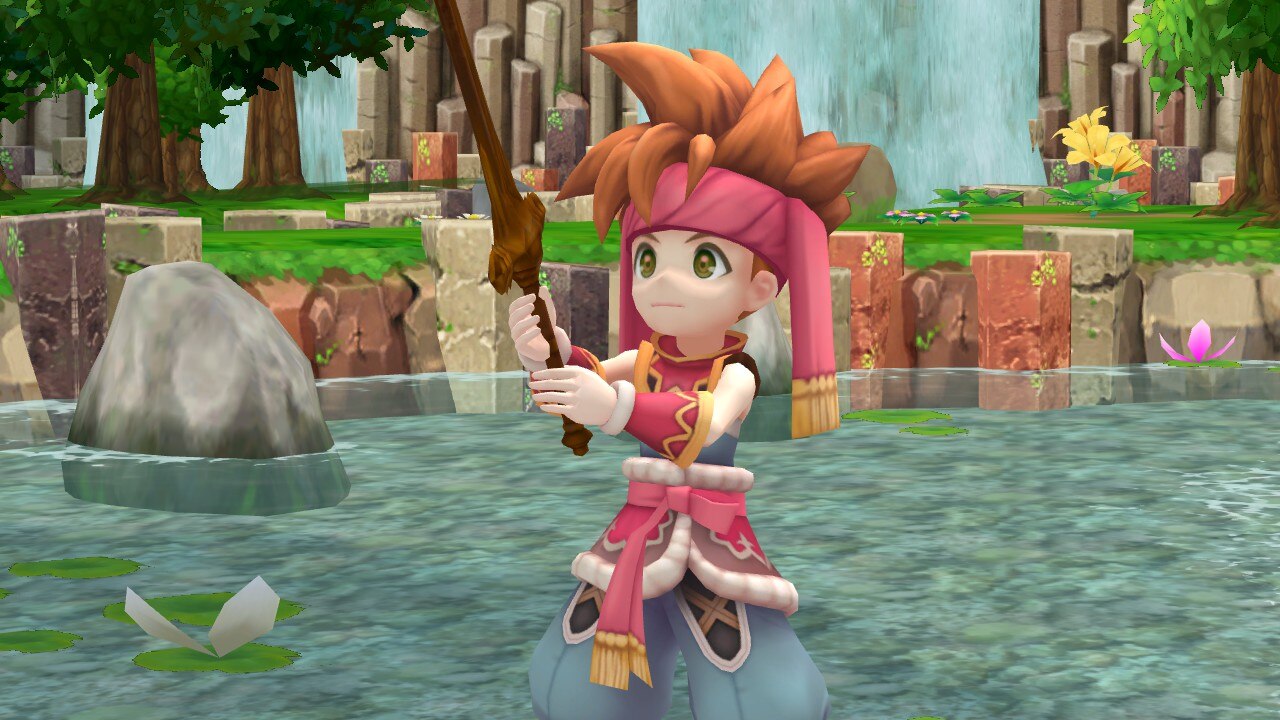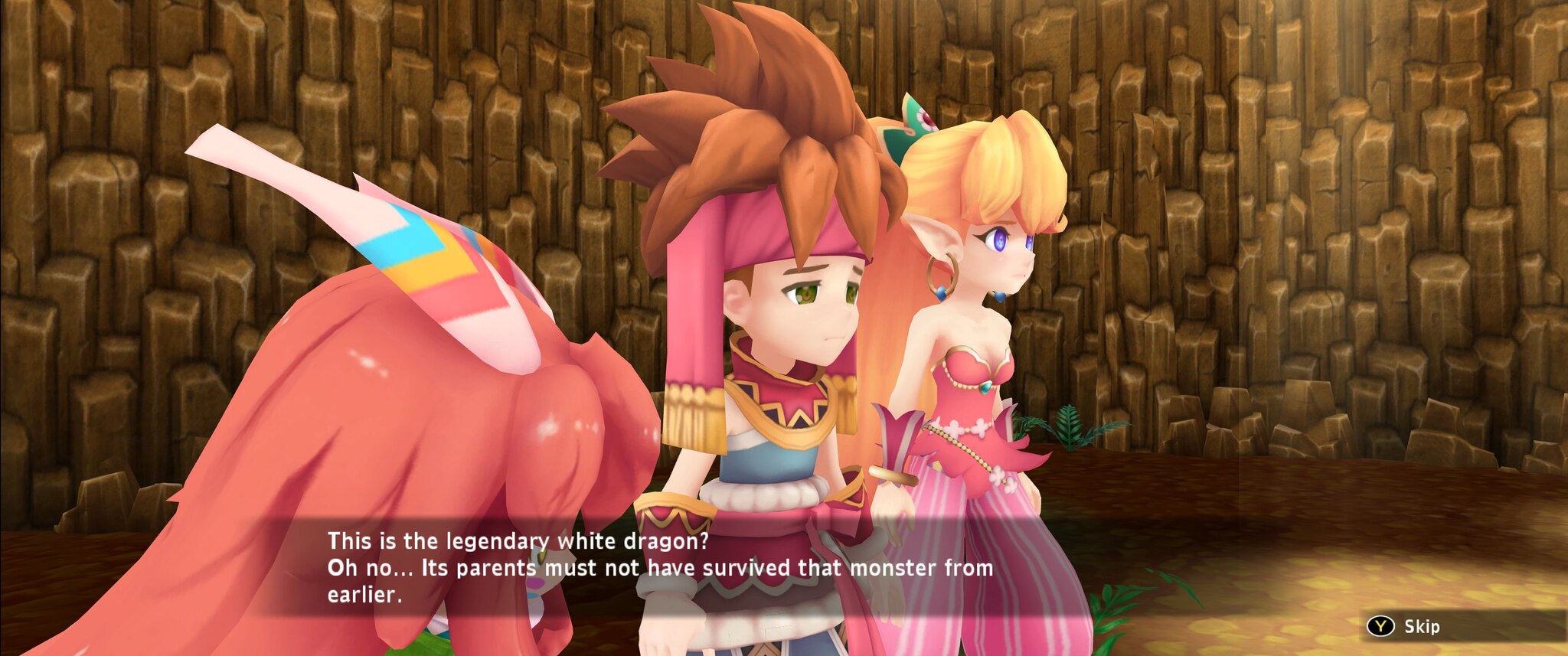Search
[{{{type}}}] {{{reason}}}
{{/data.error.root_cause}}{{{_source.title}}} {{#_source.showPrice}} {{{_source.displayPrice}}} {{/_source.showPrice}}
{{#_source.showLink}} {{/_source.showLink}} {{#_source.showDate}}{{{_source.displayDate}}}
{{/_source.showDate}}{{{_source.description}}}
{{#_source.additionalInfo}}{{#_source.additionalFields}} {{#title}} {{{label}}}: {{{title}}} {{/title}} {{/_source.additionalFields}}
{{/_source.additionalInfo}}Secret of Mana (PC)

Secret of Mana
Developed By: Square Enix
Published By: Square Enix
Released: February 16, 2018
Available On: Windows, PS4, PSVita
Genre: Action RPG
ESRB Rating: E10+ for Everyone 10+ (Fantasy Violence; Mild Suggestive Themes)
Number of Players: 1-3 players co-op, local or Remote Play Together
Price: $39.99
(Humble Store Link)
Secret of Mana was first released in 1993 on the SNES, and is one of the earliest games to really put Action RPGs on the map. With an epic storyline, killer aesthetics, and ability to play with two friends, there was a lot to like about it. It is undoubtedly one of the most beloved JRPGs from the golden age of JRPGs, and that’s saying quite a lot already about its overall quality. As part of the World of Mana 25th Anniversary initiative, Square Enix set about remaking the game for modern systems, and they managed to do that on schedule for a 2018 release.
The story begins with adopted orphan Randi and his friends exploring the forest around his home village of Potos. Randi is soon separated, and draws out a rusty sword embedded in stone – and that’s usually a sign that an epic story is about to begin. After fighting his way back to the village, he meets with a knight who recognises the sword, and is instructed to restore the sword’s magical powers for the coming worldly peril. He is soon joined by the elegant but fiery Primm eager to save her beloved Dyluck, and shortly after by the lost sprite Popoi who seeks to return home. Suffice it to say that Primm and Popoi’s goals eventually come to align with Randi’s. They must visit the world’s eight elemental temples to restore the Mana Sword, and then defeat the Vandole Empire. Along the way they’ll run into the comedic banditry of the Scorpion Army, defeat the dark mind control cult of Thanatos, and learn from the wise sage Joch.
Besides the main story, staying at an inn will play short dialogues between the three heroes. In these dialogues you’ll get to know and understand their hopes, dreams and motivations, and also their reflections on what has happened so far in their journey. There are plenty of laughs and light-hearted takes here, and these slices of life are quite true to life with how friendships are deepened, right down to the dumb arguments over things nobody cares about. By the end of the 20 hours it takes to finish the game, you’ll really feel for these three teenagers.
The game is played from a top-down perspective in a similar fashion to modern hack-n-slash titles such as Hades or Bastion. Navigate the world, and fight with enemies as you encounter them like an action game. Tap the attack button to swing with your equipped weapon, and then wait for the weapon to tick back up to 100% power before attacking again unless you enjoy missing with your attacks. If you have levelled up your character’s weapon skills, you can hold down the attack button to charge beyond 100% for more potent charge attacks. Although combat is handled in real time, this waiting around for 100% turns it into a de facto turn-based combat system. The damage bonus for charge attacks is also generally quite low, so it’s only worth charging during boss invulnerability phases. Hold the dash button to run around, which is useful for running past sections with lots of hard-to-kill enemies. The radial menu buttons allow you to use healing items or cast magic with Primm and Popoi. Finally, you can switch control between characters at any time. As you defeat enemies and cast spells, you will level up your weapon skills, magic skills, and character stats. You’ll also find or purchase new weapons, orbs to upgrade the weapons, and new armour pieces to improve your defences.

Strong Points: Epic story; updated script; evocative soundtrack; gameplay is faithfully imported
Weak Points: Old bugs have also been imported
Moral Warnings: Cartoon violence; demons and undead as enemies; fantasy magic
The mechanics are without a doubt imported very faithfully from the original 1993 game – and perhaps a little too faithfully in some cases. Enemies are still limited to three at a time. Allied radial menus still can’t be opened while they’re in the middle of an attack or casting animations, and this might be the pain point on usability to modern audiences. Square Enix could have added the ability to queue commands if the intent was to modernise the controls. The presence of an Evasion stat on characters and enemies also flies in the face of a lot of modern action games, and might take a bit of getting used to if you’ve never played older Action RPGs. There are also some geometry quirks as well. If you find yourself unable to walk across what appears to be a clear passage, try charging your weapon and attacking over it; this will be necessary in Gaea’s Navel. These geometry bugs and allied radial menu issues are also present in the 1993 original.
Attacks are now executed in full 360 degrees, rather than in the four cardinal directions only. The Boomerang and Javelin weapons lose a lot of usability since their attacks struggle to hit enemies on different elevations. Ranged enemies benefit significantly from this change though, and it’s a lot harder now to advance on Chobin Hoods when they have no blind spots on their diagonals. Ally AI has also been stripped down. The Action Grid is gone, replaced by a simple set of orders which leads to your allies doing a lot less than before. Ally pathfinding is as terrible as it was in the original game, and they’ll still get stuck on level geometry. The camera is a little bit lower, but is now centred on the player instead of only following when nearing the edge of the screen. Another big change is that Primm and Popoi now regain full MP on levelling up, which makes grinding magic levels a lot less painful.
The transition to 3D assets is quite faithful. Character models, monster models, and spell effects are all faithful to the charming whimsy of their original sprites, although the Steamed Crab loses its expressive eye stalks. Every location is recreated in detail, from the plains surrounding Pandora, to the fairy tale tundra of the Ice Country, to the gleaming Golden Tower. The minimap even uses the original SNES bitmaps! I appreciated this little nod to the past. Character poses are used in place of detailed animations, but don’t let the lack of lip flaps distract you from the epic story. The voice acting quality is on par with modern JRPGs. The script and writing changes are without a doubt far superior in the remake since they’re not bound by the character limits of the original engine, FuSoYa patch aside.
The soundtrack has undergone quite a few changes. Free from the limitations of the SNES hardware, Hiroki Kikuta’s work has been remixed by a new generation of composers. “Fear of the Heavens” is still the breath-taking title screen piece it always was. The summertime vibe of “What the Forest Taught Me” loses some of its simple joys, adding a nuanced nostalgia with the addition of violins. “A Wish…” nails the wintery wistfulness of its original version. “Still of the Night” adds a tone of tragedy to its soft lullaby. “Prophecy” mixes its mythology with an electric touch of chaos. The earlier pieces have gained a hint of fairy tale magic, while the later pieces herald the world’s impending doom more ominously than before. The remixed tracks are undoubtedly the superior option for the few cinematic sequences and standalone listening, but when playing the game, the original soundtrack is still arguably the better option. Regardless of which soundtrack you choose though, it’s sure to be a wild and emotional ride.

Higher is better
(10/10 is perfect)
Game Score - 86%
Gameplay – 17/20
Graphics – 9/10
Sound – 9/10
Controls – 4/5
Stability – 4/5
Morality Score - 87%
Violence – 7/10
Language – 10/10
Sexual Content – 9/10
Occult/Supernatural – 6/10
Cultural/Moral/Ethical – 10/10
+Fellowship (3%)
Secret of Mana’s 2018 release is marred by a number of complaints with its engine stability. I didn’t play it then, but here in 2021 I didn’t have any issues with the game crashing. After leaving Potos at the start of the game, I made a beeline for Pandora. After being turned around at the gate, the game started dropping frames and experiencing slowdown for a few minutes, but it was back to smooth sailing by the time I made it to the Water Palace. Interestingly, this bug is also in the original SNES game. Besides the previously mentioned geometry bugs, I came across no other stability issues. Considering all this, it wouldn’t surprise me if the Remake is actually running the original game under the hood, in much the same way that the Master Chief Collection is actually running the original game engine for Halo with a graphical overlay.
To the moral side of things, Secret of Mana is undoubtedly packed with violence in its combat, but all enemies are monsters. Even the humanoid looking enemies are, diegetically, supposed to be humans that have turned into monsters. There are no displays of blood or gore, and corpses simply puff out of existence, although a few enemies do explode momentarily into a pile of bones. Language is perfectly tame. Bikini armor is present and modelled as an item, but character models don’t change to reflect equipped armor. Popoi uses the "they/them" pronouns, but this is taken from the original 1993 Japanese script rather than being a function of modern transgender agendas.
Magic is of the fantasy variety, with characters invoking elemental spirits to cast magic spells. Demons and various undead are also present as enemies, and there is reference to an underworld realm of Mavolia. The wise sage Joch and the village of Mandala are vague references to Eastern religions. One major side story involves a mind control cult siphoning off the life force of its followers. The game also showcases the consequences of contracting with evil or messing with magic. Santa is present in the game as one of these showcases. Whatever your misgivings with Santa’s commercial incarnation, it should be noted that he traces his ancestry back to the very real bishop Saint Nicholas of Myra. Additionally, the dialogues triggered by staying at an inn portray a fellowship that lines up very well with Christian understandings of fellowship. There is a valid (if implied) lesson here that friends and fellowship are built gradually over time, and that these relationships can help us with handling mental and emotional burdens.
The remake is faithful to the original game, even to a fault in some cases. Don’t let the outdated action combat turn you off though, there is still an epic story to be experienced here and the moral concerns are quite mild. For those who have played the original either on the SNES or via the Collection of Mana, there’s not much new here. For everyone else, it’s time to learn the Secret of Mana.








